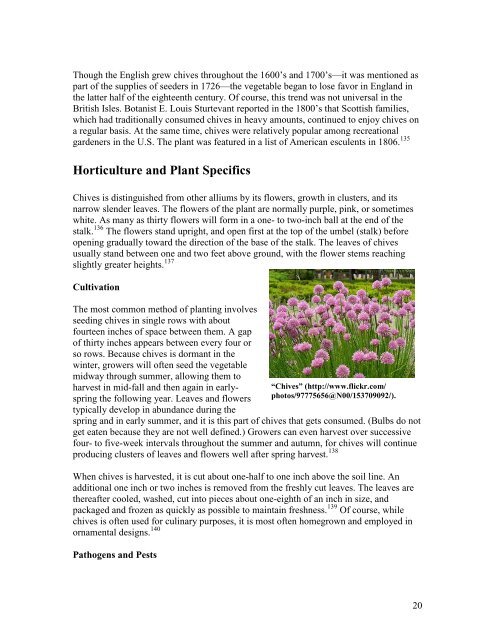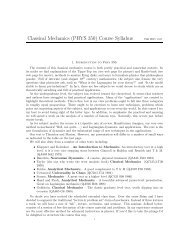Leek Scientific Classification and Etymology - Academics - Hamilton ...
Leek Scientific Classification and Etymology - Academics - Hamilton ...
Leek Scientific Classification and Etymology - Academics - Hamilton ...
Create successful ePaper yourself
Turn your PDF publications into a flip-book with our unique Google optimized e-Paper software.
Though the English grew chives throughout the 1600’s <strong>and</strong> 1700’s—it was mentioned as<br />
part of the supplies of seeders in 1726—the vegetable began to lose favor in Engl<strong>and</strong> in<br />
the latter half of the eighteenth century. Of course, this trend was not universal in the<br />
British Isles. Botanist E. Louis Sturtevant reported in the 1800’s that Scottish families,<br />
which had traditionally consumed chives in heavy amounts, continued to enjoy chives on<br />
a regular basis. At the same time, chives were relatively popular among recreational<br />
gardeners in the U.S. The plant was featured in a list of American esculents in 1806. 135<br />
Horticulture <strong>and</strong> Plant Specifics<br />
Chives is distinguished from other alliums by its flowers, growth in clusters, <strong>and</strong> its<br />
narrow slender leaves. The flowers of the plant are normally purple, pink, or sometimes<br />
white. As many as thirty flowers will form in a one- to two-inch ball at the end of the<br />
stalk. 136 The flowers st<strong>and</strong> upright, <strong>and</strong> open first at the top of the umbel (stalk) before<br />
opening gradually toward the direction of the base of the stalk. The leaves of chives<br />
usually st<strong>and</strong> between one <strong>and</strong> two feet above ground, with the flower stems reaching<br />
slightly greater heights. 137<br />
Cultivation<br />
The most common method of planting involves<br />
seeding chives in single rows with about<br />
fourteen inches of space between them. A gap<br />
of thirty inches appears between every four or<br />
so rows. Because chives is dormant in the<br />
winter, growers will often seed the vegetable<br />
midway through summer, allowing them to<br />
harvest in mid-fall <strong>and</strong> then again in earlyspring<br />
the following year. Leaves <strong>and</strong> flowers<br />
typically develop in abundance during the<br />
“Chives” (http://www.flickr.com/<br />
photos/97775656@N00/153709092/).<br />
spring <strong>and</strong> in early summer, <strong>and</strong> it is this part of chives that gets consumed. (Bulbs do not<br />
get eaten because they are not well defined.) Growers can even harvest over successive<br />
four- to five-week intervals throughout the summer <strong>and</strong> autumn, for chives will continue<br />
producing clusters of leaves <strong>and</strong> flowers well after spring harvest. 138<br />
When chives is harvested, it is cut about one-half to one inch above the soil line. An<br />
additional one inch or two inches is removed from the freshly cut leaves. The leaves are<br />
thereafter cooled, washed, cut into pieces about one-eighth of an inch in size, <strong>and</strong><br />
packaged <strong>and</strong> frozen as quickly as possible to maintain freshness. 139 Of course, while<br />
chives is often used for culinary purposes, it is most often homegrown <strong>and</strong> employed in<br />
ornamental designs. 140<br />
Pathogens <strong>and</strong> Pests<br />
20






